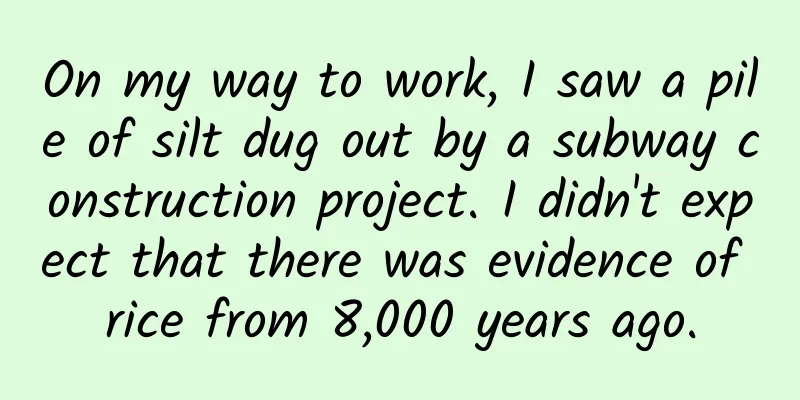On my way to work, I saw a pile of silt dug out by a subway construction project. I didn't expect that there was evidence of rice from 8,000 years ago.

|
Rice is of great significance to us. It not only feeds nearly half of the world's population today, but also plays a vital role in the development of human civilization. About 10,000 years ago, ancient humans in the East and the West domesticated rice and wheat at about the same time, allowing humans in both the East and the West to transform from primitive societies of gathering, fishing and hunting to agricultural societies, and finally enter a new era of civilization. A large amount of archaeological evidence shows that the middle and lower reaches of the Yangtze River are the "homeland" of rice. For example, precious records of primitive domesticated rice dating back more than 8,000 years have been unearthed at the Shangshan Culture Site Group in the Qiantang River Basin (about 11,000-8,400 years ago), the Pengtoushan Site in the middle reaches of the Yangtze River (about 9,000-7,800 years ago), and the Shunshanji Site in the Huaihe River Basin (about 8,500-7,500 years ago). Part 1 Traditional archaeological methods : digging and digging on a large piece of land Traditional archaeological work is to find the remains of the ancestors through field archaeological excavations. In field archaeology, archaeologists mainly obtain physical materials through field investigations, stratigraphic drilling and field excavations - that is, the image of a group of archaeologists squatting in a pit and waving small shovels and brushes that we often see on TV. So far, field archaeology has achieved great results. For example, nearly 200 sites of prehistoric rice remains have been discovered in China, and among them, there is evidence of the earliest rice planting behavior thousands of years ago, which was found at the Shangshan site in Puyang, Zhejiang. However, traditional archaeology also faces some insurmountable limitations when revealing the life of the ancients. The first problem is that some relics may be buried too deep due to their age , beyond the reach of traditional archaeological excavation technology; secondly, sometimes the preservation of the strata is not ideal, affected by natural factors or human activities, making it difficult to discover many valuable clues. In addition, the choice of excavation site is also crucial. If it is too far from the center of ancient people's activities, even if in-depth excavation is carried out, it may be difficult to find obvious signs of survival. What is more difficult is that with the continuous advancement of urban construction, the construction of buildings and infrastructure often destroys or buries underground prehistoric cultural relics. This not only increases the difficulty of archaeological work, but also makes it possible for many evidences related to primitive rice farming to be missed or undiscovered. Archaeologists are conducting field archaeological work at Sanxingdui (Image source: CCTV News screenshot) These limitations lead to a practical problem, that is, based on field archaeological evidence, the evidence of primitive rice agriculture in the Yangtze River Delta seems to be older than in other regions. Generally speaking, scientists believe that the domestication of rice may be closely related to historical climate change processes. About 10,000 years ago, the cold last ice age ended, the climate gradually warmed and became humid, and the Yangtze River Delta gradually formed, which provided a vast living space and superior wetland environment for the ancient ancestors in the lower reaches of the Yangtze River. In the Ningshao Plain of Zhejiang Province, south of the Yangtze River Delta, similar sea level rise and climate change have been experienced over the past 10,000 years, prompting the rice in the region to embark on the road of domestication 8,000 years ago. At the same time, despite the relatively cold climate conditions in the Yellow River Basin in the north, records of rice cultivation were also found during the same period. Puzzlingly, in the lower reaches of the Yangtze River, located between the Qiantang River Basin and the Huanghuai region, no empirical reports of rice earlier than 8,000 years ago have been found. Distribution map of the main archaeological sites where rice remains were unearthed 8,000 years ago (Photo credit: Deng Zhenhua) This raises the question: Do early records of rice exist in the Yangtze River Delta? If so, why are they later than those in other regions? Did ancient humans skip the rice cultivation stage in this region, or did traditional archaeological methods fail to find relevant evidence? When traditional archaeological methods fail to obtain relevant evidence, environmental technology archaeology can undoubtedly play a huge role. Part 2 8,000-year-old evidence of rice found in Nanjing By chance, when passing by the ruins of the Ming Palace on their daily commute, researchers accidentally observed the soil cores drilled by the Metro Urban Construction Geological Survey Institute. These cores were homogeneous and fine blue-black in color and rich in organic matter, which aroused the great interest of the researchers. They speculated that these soil cores were likely to be valuable samples left over from lake-phase sediments. According to historical records, this area was once the site of the ancient Yanque Lake. During the Ming Dynasty, Zhu Yuanzhang "moved three mountains and filled Yanque" to build his capital. By transporting soil to fill the lake, the lake area was gradually transformed into land. This historical record further supports the researchers' speculation that these sediments did come from ancient lake deposits. Partial core image of the MGG3 borehole at Houzaimen of the Ming Palace in Nanjing (Photo credit: Shu Junwu) Lake sediments are mainly brought by rivers and wind, with a relatively stable and continuous deposition rate, and they also carry a large amount of biological indicators such as pollen. These biological indicators are valuable clues for us to reveal the evolution of ancient vegetation, climate and environment. Therefore, these sediments are known as the "stratum book" that records ancient ecology and are important materials for researchers to study ancient environments. Among them, pollen is the most important. As the male reproductive organ of seed plants, pollen is tiny, ranging from a few microns to 200 microns, and its morphology can only be observed with the help of a microscope. Pollen is huge in quantity and hard in texture, so it is widely distributed in sediments. Since there is a good correspondence between the morphology of pollen and the parent plant, by analyzing the types and quantities of pollen in the sediments, researchers can better reproduce the characteristics of the surrounding vegetation when the sediments were formed, and further infer the climate and environmental conditions at that time. By analyzing the occasional lake sediment samples obtained during this period, the researchers found rice-type grass pollen that persisted at a certain content in the sediments at or above 16.9 meters from the surface of the sediment borehole. According to 14C dating analysis, the earliest stable layer of these pollens is 8,200 years ago. The evidence of rice-type pollen (diameter ≥ 38 microns) found in the sediments of the Ming Palace area is very likely to indicate that primitive rice cultivation activities have lasted for a long time in Nanjing since 8,200 years ago. This discovery not only reveals the history of early agricultural activities in Nanjing, but also provides valuable clues for studying ancient climate and environmental changes. The morphology of living rice pollen under an optical microscope (Photo credit: Mao Limi) Coincidentally, in the sediments of Nanjing Liuhe, which is across the river from the Nanjing Ming Palace area, evidence of rice phytoliths that have existed for a long time since 8,200 years ago was also found. Phytoliths are siliceous particles formed by the precipitation of soluble silicon components in water in plant cells or between cells during the process of plant water absorption. Their individual sizes range from a few microns to 200 microns. Similar to pollen, phytoliths also have excellent characteristics in indicating ancient vegetation and ancient environment, and therefore have become a commonly used research method in environmental archaeology in recent years. This discovery also shows that rice cultivation has been going on for a long time in this area since 8,200 years ago. 8200-year-old rice phytoliths found in sediments in Liuhe, Nanjing (Image source: Zuo X, et al. 2016) The earliest known primitive agricultural site in Nanjing is the Beiyinyangying site in Gulou District, which dates back about 6,000 years. However, based on the newly discovered rice pollen and rice phytolith evidence, we can infer that the ancestors of Nanjing probably started primitive rice cultivation at least 8,200 years ago. This major discovery not only reveals important information about human activities that is difficult to access through traditional field archaeology, but also pushes the history of agricultural activities in the lower reaches of the Yangtze River forward by at least 1,200 years. In recent years, the importance of scientific and technological archaeology has become increasingly apparent in the in-depth exploration of ancient agricultural history. "Alternative archaeology" carried out with the help of modern scientific and technological means such as drilling and experimental analysis can not only effectively make up for the limitations of traditional archaeology in large-scale excavations, but also widely track archaeological information related to agriculture, the environment, etc. This organic combination of new scientific and technological archaeology and traditional archaeological work provides us with more physical evidence and further improves our understanding of prehistoric agriculture. By deeply analyzing these evidences, we can "see through objects and see people", reveal more historical pictures about the living conditions of ancient humans, details of agricultural activities, etc., and provide a richer and deeper perspective for understanding the development of ancient Chinese civilization. References: [1]Zuo, [2]Ge, J., et al., Revealing early Neolithic vegetation and environmental changes in the Lower Yangtze Valley, eastern China: Pollen insights, Review of Palaeobotany and Palynology (2024), https://doi.org/10.1016/j.revpalbo.2024.105060. [3]He, K., et al., Role of dynamic environmental change in sustaining the protracted process of rice domestication in the lower Yangtze River, Quaternary Science Reviews (2020), https://doi.org/10.1016/j.quascirev.2020.106456. [4]Tang S, Ding L, Bonjean AP A. Rice production and genetic improvement in China[J]. Cereals in China, 2010, 15. Source: Science Institute |
<<: Why is it that you can swat a mosquito with your hands, but it is so hard to swat a fly?
>>: From the laboratory to commercialization, is the era of humanoid robots really coming?
Recommend
In the era of content e-commerce, what are the techniques for improving conversion rates?
Yippin’s online [Pin Shuo] column did a discussio...
Android 11 is not used yet, Android 12 is coming with these 3 strong points, completely aligning with IOS
What do you think of when you talk about Android?...
What kind of wine is suitable for drinking in winter? What kind of wine should I give as a gift?
What kind of wine is suitable for winter? Drinkin...
New breakthrough in the exploration of extraterrestrial life, the "Drake Equation" may help solve it!
Drake equation crucial to calculating the amount ...
The training footage of China’s earliest astronauts was exposed. They flew into the blue sky just for more than 40 seconds of weightlessness!
Shenzhou 13 "Space Trio" In orbit for m...
The barbaric P2P online lending has seen the dawn of civilization
For the P2P industry, the impact of policies has ...
How to understand a famous book?
Mixed Knowledge Specially designed to cure confus...
10 insights behind the 120,000 yuan marketing campaign
Holiday campaigns have always been the focus of b...
How is a brick of the Great Wall fired?
Starting from Shanhaiguan in Hebei in the east an...
China Association of Automobile Manufacturers: Economic Operation Data of Automobile Industry in February 2020
In February 2020, affected by the COVID-19 epidem...
Baidu announces the opening of its autonomous driving platform
Baidu has launched a new program called "Apo...
How to effectively promote the product in the early stage?
"Successfully executing a plan that makes no...
How much is the price to join Taizhou Dry Goods Mini Program? Taizhou Dry Goods Mini Program Franchise Price Inquiry
How much does it cost to join the Taizhou Dry Goo...
Fish and meat are falling from the sky?! Can I pick them up and take them home to eat?
In the movie "The Angry Sea" released n...









